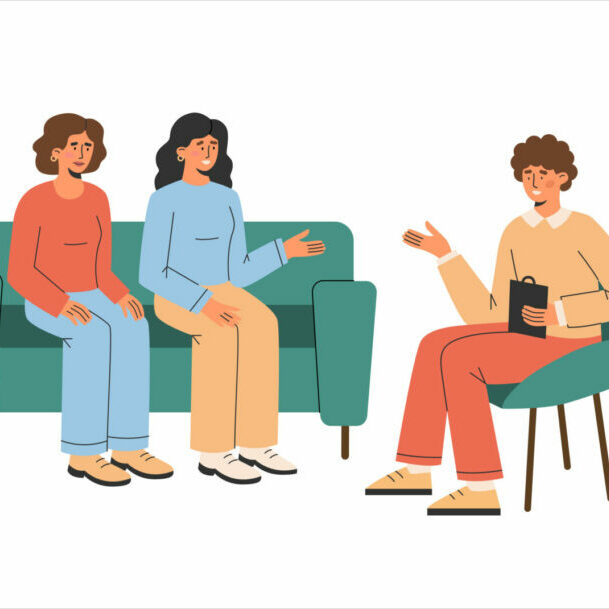Navigating Identity: Considerations for Polyamorous Relationships Among LGBTQ+ People

In recent years, society has witnessed a remarkable shift in the recognition and acceptance of diverse relationship models. Among these, polyamorous relationships have emerged as a valid and fulfilling alternative to conventional monogamy.
Queer relationships, likely because of their lesser susceptibility to the norms of traditional gender roles, have seen an increase in clearly identified (e.g., “out”) polyamorous relationships.
However, for individuals within the LGBTQ+ or queer community, navigating the complexities of polyamory can still present unique challenges. Let’s explore the intersection of polyamory and LGBTQ+ identities, emphasizing the crucial role of LGBTQ+ therapy in providing support and guidance on this journey.
What Does it Mean to be in a Polyamorous Relationship?
Polyamorous relationships challenge the traditional notion of monogamy by embracing openness, honesty, and ethical communication. Unlike cheating, which involves deception and betrayal, polyamory prioritizes consent and mutual respect among all partners involved.
It’s essential to differentiate polyamory from other forms of non-monogamy, such as open relationships and swinging, which may lack the same depth of emotional connection and communication.
- Exploring the Intricacies of Polyamory – Polyamorous relationships, while often misconstrued, embody a deeply ethical approach to romantic connections. Unlike conventional monogamy, where exclusivity is paramount, polyamory thrives on the principles of honesty, consent, and emotional transparency.
A primary tenant of many polyamorous relationships is that it is not rational that a single person (even one engaged monogamously) can meet all of one’s needs. In polyamorous dynamics, individuals engage in multiple romantic relationships simultaneously, with the full knowledge and consent of all parties involved. This paradigm shift challenges societal norms and encourages individuals to explore the vast spectrum of human connection.
- Variations in Polyamorous Relationship Structure – Polyamorous relationships come in various forms, including hierarchical and non-hierarchical arrangements, each with distinct features and dynamics. In hierarchical polyamory, there’s a primary relationship that takes precedence in terms of time, energy, and decision-making, whereas secondary and tertiary relationships might have more defined boundaries and less influence.
This structure can provide clarity and stability for those involved, but may also lead to feelings of inequality or less importance among partners not in the primary relationship. Non-hierarchical polyamory, on the other hand, eschews such rankings, treating all relationships as equally important, which encourages a more fluid and egalitarian approach to love and commitment. While this can foster a sense of fairness and inclusivity, it also demands strong communication skills and boundary management to navigate the complex dynamics that arise without established hierarchies.
- Myths About Polyamorous Relationships – Dispelling misconceptions surrounding polyamory is essential for fostering understanding and acceptance. Contrary to popular belief, polyamory is not an escape from commitment but requires a high level of emotional maturity, communication skills, and respect for boundaries. Additionally, polyamory is not inherently easier than monogamy; it simply presents its own set of challenges and rewards. Addressing jealousy and envy, common concerns requires open communication and self-awareness within the relationship.
Is a Polyamorous Relationship Right for Me?
Determining whether a polyamorous relationship aligns with one’s needs and values is a deeply personal journey. Understanding one’s attachment style, emotional needs, and communication preferences is crucial. Every individual navigates relationships differently, and what works for one person may not work for another. Exploring desires and boundaries in a safe, non-judgmental environment can be facilitated through queer or LGBTQ therapy.
Challenges Faced by Polyamorous Queer People:
Despite increasing acceptance, individuals at the intersection of polyamory and queer/LGBTQ+ identities may encounter unique challenges. Discrimination, both external and internalized, can impact self-esteem and contribute to feelings of isolation.
Moreover, societal misconceptions about polyamory may lead to marginalization within queer and LGBTQ+ spaces. In such instances, LGBTQ+ therapy provides a supportive environment to process experiences, validate feelings, and find empowerment.
The Role of Queer Affirming and LGBTQ Therapy in Supporting Polyamorous Individuals:
Queer affirming and LGBTQ therapy offer a safe and affirming space for individuals to explore their identities and relationships. For people who are poly or exploring polyamory, therapy facilitates navigating multiple partnerships, addressing communication challenges, and processing complex emotions.
Therapists trained in LGBT affirming therapy approach polyamory without judgment, have knowledge of polyamory and validate clients’ experiences and identities. Working with a queer or LGBTQ therapist provides the opportunity to explore and understand what being in a polyamorous relationship means to you.
Building Healthy and Fulfilling Polyamorous Relationships:
Polyamory offers opportunities for growth, intimacy, and connection, alongside its challenges. Queer affirming and LGBTQ+ therapists help individuals and partners cultivate healthy relationships by developing effective communication skills, understanding relationship roles, setting boundaries, and managing complex feelings.
Through introspection and relational skills building, clients learn to prioritize self-care and mutual growth within their relationships. Polyamory is built on the need for communication and trust between partners. Fostering this trust while developing insight into attachment needs and insecurities is crucial in developing healthy and fulfilling relationships.
Addressing Unique Challenges with an LGBTQ Therapist:
In the context of polyamory, queer therapy addresses the unique challenges faced by people navigating multiple marginalized identities. Discrimination, stigma, and internalized shame can impact self-esteem and hinder authentic self-expression within poly relationships.
LGBTQ+ therapists provide a compassionate and affirming space to explore these challenges, fostering self-acceptance and resilience. Therapeutic Approaches for Polyamorous Relationships: LGBTQ+ therapists employ a variety of therapeutic approaches, including IFS, EFT, CBT, and others, to support polyamorous individuals and relationships.
The Importance of Community and Support:
Community support is essential for individuals navigating polyamorous relationships within the queer community. An LGBTQ therapist may suggest group therapy or community engagement, providing a sense of belonging and validation among peers in similar situations. By sharing experiences and resources, individuals can build resilience and collective empowerment within the poly community and broader queer community.
In conclusion, navigating polyamorous relationships as a queer or LGBTQ+ individual require intentionality, support, and self-awareness. LGBTQ+ therapists serve as a vital resource in providing affirming guidance and validation to those exploring non-traditional relationship structures.
By embracing principles of consent, communication, and self-acceptance, poly individuals can cultivate relationships that honor their identities and foster mutual fulfillment. As society continues to evolve in its understanding of diverse relationship models, queer-affirming and LGBTQ+ therapy remain integral in supporting the well-being and resilience of polyamorous individuals within the LGBTQ+ community.
This blog is made for informational and educational purposes only. It is not medical advice. The information in this blog is not intended to (1) replace a one-on-one relationship with a qualified licensed health care provider, (2) create or establish a provider-patient relationship, or (3) create a duty for us to follow up with you.



